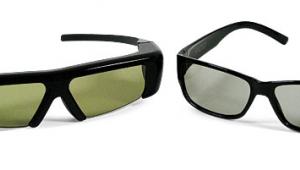"If you were watching the picture while lying on your side, you wouldn't see anything, since the glasses would be oriented so they block the light that each filter is designed to pass." Uh, no - you would simply see the left image with your right eye and the right image with your left eye. More to the point, tilting your head to the side would allow some of the other eye's image into each eye, resulting in a nasty blurred double image.fdpes6 I have a feeling the IMAX 3D theatres at the Kennedy Space Center used linear polarization - I seem to recall tilting my head leading to a blurred double image.
Passive Polarization

Let There Be Polarized Light
Before we get to polarized 3D, we need to understand a little physics of light. Visible light is a form of electromagnetic radiation, which consists of oscillating electrical and magnetic fields at right angles to each other. Normally, the orientation of these fields to the rest of the world is random, but if the oscillations are constrained to one particular orientation—say, the electrical field oscillates horizontally and the magnetic field oscillates vertically—the light is said to be polarized.
The vibrational frequency of the two fields is always the same—it determines the color of the light—but their phase relationship can vary. If the two fields are in phase, this condition is called linear polarization as depicted in the left portion of the diagram above; if they are 90 degrees out of phase, it is called circular polarization as shown on the right. In both cases, the orange wave in the diagram is the combination of the electrical and magnetic waves.
As you can see, in linear polarization, the combination wave maintains a constant angle with respect to the electrical and magnetic waves. By contrast, in circular polarization, this angle changes over time, forming a "corkscrew" as the light travels.
In circular polarization, the electrical and magnetic fields can be 90 degrees out of phase in one of two ways—the electrical-field oscillation can be ahead of the magnetic-field oscillation or vice versa. The resulting corkscrews are called clockwise and counterclockwise because they "rotate" in opposite directions.
Polarized 3D
Okay, now that we have the background out of the way, let's see how polarization allows 3D images to be displayed. You might have already guessed that all you need to do is display the left- and right-eye images using different polarization for each one. Then, you need to wear glasses with filters that allow only light with the left-eye polarization to reach the left eye and light with the right-eye polarization to reach the right eye.
For example, you could use linear polarization, with the left-eye image being horizontally polarized—that is, the orange combination wave in the diagram is oriented horizontally—while the right-eye image is vertically polarized. Of course, the left filter in the glasses must let only horizontally polarized light through and the right filter must let only vertically polarized light through.
This works just fine—until you tilt your head, which allows some of the light from both images to get through both filters, leading to unacceptable crosstalk. If you were watching the picture while lying on your side, your left eye would see the right-eye image and vice versa.
A better approach is to use circular polarization—say, clockwise for the left-eye image and counterclockwise for the right-eye image, with corresponding filters in the glasses. In this case, you can tilt your head and still see the image. In fact, that's why most polarized 3D theaters use circular polarization.
Display Options
How are the left- and right-eye images displayed in a polarized system? In most commercial cinemas, especially those using RealD technology, a digital projector alternately displays the left- and right-eye images at a rate of 144Hz, or 72Hz per eye, using a synchronized circular polarizer that switches between clockwise and counterclockwise at the same rate. Of course, the film frame rate is 24fps, so each eye sees each frame three times.
Polarized 3D projectors for home theaters will do much the same thing, but most likely at 120Hz, or 60Hz for each eye. For 24fps movies, that means introducing 3:2 pulldown, which is not optimal. Perhaps a manufacturer will develop a 240Hz 3D projector, which would allow 120Hz for each eye and display each film frame five times, avoiding 3:2 pulldown.
Many Imax 3D theaters use two digital projectors—one for the left eye and the other for the right eye—to increase the amount of light, a very good thing for 3D on such a large screen. And for some reason I've yet to understand, they use linear polarization. The next time you attend an Imax 3D movie, try tilting your head to one side or the other during the show to see the left and right images become visible to both eyes. (If you don't see this, the theater you're in uses circular polarization.)
All polarized projection systems have one major drawback—they require a special silver screen that preserves the polarization from the projector. Such a screen suffers from hot-spotting and color-shifting, which is not great for 3D and even worse for 2D. So the best-case scenario for a theater in which 2D and polarized 3D programs are shown is to have two screens that can be moved into position as needed. Unfortunately, I doubt that many commercial venues will go to this expense, which means that 2D movies in a polarized 3D theater will be seriously compromised.
Direct-view flat panels can also use polarization to achieve a 3D effect—one such product is the JVC GD-463D10 46-inch LCD TV, which was introduced at CEDIA last year for a list price of nearly $9000. With flat panels, alternate horizontal lines on the screen are used to display the image for each eye—for example, the odd-numbered lines might be used for the left-eye image while the even-numbered lines are used for the right-eye image. Of course, this so-called "line-interleaved" approach cuts the vertical resolution for each eye in half, which is why it's not more common in consumer flat panels.
Like all 3D glasses, polarized glasses reduce the amount of light reaching your eyes, but not as much as active-shutter glasses, which close both lenses during part of each frame cycle to avoid crosstalk. This is one reason why passive glasses are used in projection systems, because they output much less light than flat panels to begin with.
- Log in or register to post comments

The IMAX theatre where I saw Avatar was using two projectors and linearly polarized glasses. A tilt of the head would produce double images, but the extinction was so good around vertical I never noticed doubling during the movie. Two projectors should allow double the frame rate over a single and circular polarized glasses.

Hi Scott, It's not the relative phase of the electric and magnetic components that is 90° shifted. In my understanding, polarisation always describes the orientation of the electric component. The magnetic component is always at 90° to the electric. This is how I understand circularly polarised light... courtesy of Wikipedia. Circularly polarised light comes about as you pass linearly polarised light through a quarter-wave plate. Consider a linearly polarised wavefront at 45°. Mathematically, this can be represented by equal magnitude vertical and horizontal "electric" vectors. i.e. the average of 0° and 90° A quarter-wave plate is able to "slow" the vectors in one orientation relative to the other. This brings about a phase shift between the vectors. A phase shift of 90° (quarter-wave) results in an electric wavefront in the shape of a helix. Polarisation is shifted clockwise or counter-clockwise by changing the relative orientation of the linear polarise

continues... Polarisation is shifted clockwise or counter-clockwise by changing the relative orientation of the linear polarised wavefront and quarter-wave plate. Clockwise occurs at 45° and counter-clockwise at 315°. Hope that all makes sense. By the way, I really enjoy your entries here and especially your Home Theater Geek podcast. Great guests, great questions, very informative and totally captivating. Regards, Steve

Another great article Scott! Interestingly, my local cinema uses the same screen for 3D and 2D movies, which both look fantastic. My wife and I had just seen Iron Man 2 there which looked very,very good! The Showing right before the movie was How to Train Your Dragon in 3D, which we had seen the week prior. I noticed that you said 3D requires a special silver screen. Our cinemas screen is white. I wonder if they are just being cheapskates? I have viewed 3D Avatar at 3 different theaters, one of which had a silver screen. It appeared to have the same picture quality as the others. Im a bit puzzled on the silver screen concept.

Jarod, only 3D systems that use polarization require a silver screen. The other type of passive system is Dolby 3D, which does not require such a screen; that's probably what the theater you saw Iron Man 2 in was using. I'll be explaining this technology in an upcoming entry.

Steve, I saw the Wikipedia entry that talks about the "electric vector" being the vector sum of the two orthogonal components, but I think this terminology is somewhat misleading. The two components are the electric and magnetic fields, and the vector sum is the electromagnetic (EM) field. Ultimately, I think you and I are talking about the same thing, just using different terminology. Thanks for the kind words about my blogs and podcast; I'm so glad you enjoy them! I just finished recording the latest podcast with Alan Kraemer, CTO of SRS labs, a very interesting and articulate audio guy.

Jarod, if the theater is using polarized glasses, it must be using a polarization-preserving screen. If it's not using such a screen, you wouldn't see the 3D effect on 3D content. I'm very glad you're enjoying the podcasts! I agree that Joel Silver was a great guest. Next week is Rick Dean, chairman of the 3D@Home Consortium, so we'll be talking all about 3D. I'll ask him if it's possible that a polarization-preserving screen could be white, but I've never heard of this before.

Hey Scott I did so more investigation and sure enough, they installed a new screen. You, as is usual, where correct! They use the new one for their 3D showings and they drop down a different screen for 2D digital showings . Thanx for makin me finally get the real scoop or our local theater which a line call Dickonson Theater. Thanx again
























































